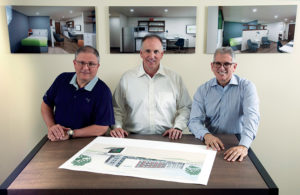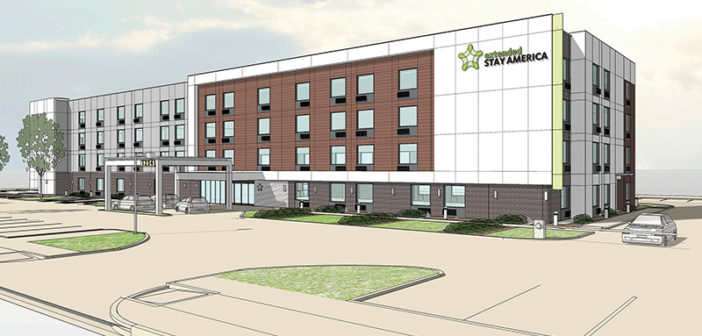NEW YORK—The stage is set and the FDD paperwork’s in progress for Extended Stay America (ESA) to join the ranks of hotel brand franchisors.
In addition to that leap, the owner/operator at the same time has created a new prototype and plans to return to new-build hotels after 10 years.
The initiatives stem from the momentum put in place in 2016 under the company’s ESA 2.0 program.
“Last year, we announced that we would endeavour to take on the next phase of the journey for our company, and that involves moving into unit growth; it involves taking our existing base of 625 hotels to the next level,” President/CEO Gerry Lopez told Hotel Business earlier this month during the annual NYU International Hospitality Industry Investment Conference. “We’re going to do that in a couple of different ways: We’re going to start buying some land and building on our own balance sheet. We will, at the same time, launch a franchising program.”

Surrounded by renderings of ESA’s new prototype are company executives (left to right) President/CEO Gerry Lopez, COO Tom Bardenett and Chief Asset Merchant Jim Alderman.
Lopez said the Charlotte, NC-based company brought on board industry veteran Jim Alderman as chief asset merchant to help with the vision for the program, which is to make sure ESA “continues to enjoy the success that it’s had all these years. We are the dominant brand in the extended-stay segment—certainly in the midscale extended-stay segment—and we want to make sure that continues. We’ve looked at the market very carefully, we’ve developed some prototypes and we’ve hired Jim and a team to take us to that next level.”
The team includes industry veterans Stephen Miller, managing director, real estate and development; Rick Canale, VP, marketing strategy and planning; and managing directors of real estate Judi Bikulege and Steve Scheetz.
“I’m going to get out of the way and let the veterans take care of business and do what they’re so good at,” said the CEO.
“We only have one goal, and that’s to do as many of these on a thoughtful basis as possible,” said Alderman, adding, “This is the only company out there that I know of in the hospitality business that’s actually growing through disposition—selling, but getting a pledge for even more units; growing through franchising and growing through selling; and taking back even franchise and management [agreements], which is something new that got introduced when we started to talk about asset sales… We’ve got multiple areas that we can continue to grow in.”
Rather than remain 100% corporate owned, ESA is now looking to skew the portfolio 70% corporate owned and 30% franchised, with a goal of having 700 ESA-branded properties by 2021.
Lopez said the company’s growth over the past five or six years has been primarily organic. “We’ve taken the properties, we’ve cleaned them up, we’ve renovated every single one of them. In fact, we just got done renovating all 625 properties, literally, last month. We’ve put in place a sales force to help us attack the corporate opportunity that we see. Today, just about half of our business is coming from the corporate side. We’ve put in place a revenue management system that the company never had before. So all of the basic building blocks that you would expect a company in the 21st century in this industry to have…the stage is essentially set,” said the CEO.
As to unit growth, Lopez said, “There’s way more opportunity out there, way more markets that can use an extended-stay property, that can use what we do, than we will, frankly, have the time or the capital to attack all at the same time. The only way we think we can reasonably target as many opportunities that are out there is by enlisting some franchisees, enlisting some partners that will benefit from the business model this company has been so successful with… The proof is in the pudding. We look forward to the challenge of setting up the first few prototypes, getting some franchisees to see it all come together the way that we think it will.”
He noted the growth would be “as big as the market opportunity that is there for us.”
According to Alderman, the base for the franchise operation is being laid by divesting existing ESAs in select markets and offering them to buyers who can put the site to its highest and best use, including franchising the newly redesigned ESA product.
“The idea with the sales would be to facilitate growth in the franchise system by getting assets that we’ve decided we no longer want to own for various reasons,” said Alderman. “One reason might be a market reason. Take, for example, Kansas City, both the Missouri side and the Kansas side. It would be a great idea to sell the whole market and get a commitment from someone to give them Kansas and give them Missouri and say: ‘You know what? We need 15 more hotels in each, and we’ll sell you our 10 hotels there with the pledge you’re going to build this up, and we won’t come in and compete with you. We won’t sell any of that territory to another franchisee as long as you commit to a certain growth-development plan.’”
“We’re also looking at it in areas where we don’t necessarily have operational density,” he continued. “One of the keys to our success is our operational-density ability to drive margins. And because we own all the properties we can utilize one guest-service agent at properties in the same market. Where we can’t do that is Alaska or in Montana; we have four [ESAs] in Alaska and two in Montana. One in Idaho. One in Iowa. Those would be great markets to turn over to franchisees. Get a great price that Wall Street likes and develop a new growth story around that franchisee and that market.”
The chief asset merchant added ESA wants to use its assets and sell to large, well-capitalized franchisees capable of developing their market areas, which might include new-construction and/or buying the existing corporate-owned ESA hotels and converting them to franchised units. “We would like to see our prospective owners ‘cluster’ operations for better efficiency and pricing power within their markets and match their local development and ownership expertise with the advantages of Extended Stay America’s scale,” he stated.
The EVP said ESA already is in discussions with several groups on portfolios that range from a baker’s dozen to 35 assets. “And there have been people who have approached us about [buying]over 100 assets at a time. When you announce that you’re selling, sometimes one of the first assumptions is: ‘Well, they have to sell.’ The good news is we don’t have to sell anything… We want to use the assets to grow,” he said. “We’re going to top-grade the portfolio, we’re going to select assets that perhaps we’ve gotten as much as we can get out of from a margin point of view, and they’re fully optimized as ESAs. We can take the money based on what it can sell for and redeploy it in an asset that can grow more. We might sell 12 and build eight with that money. And the units that we build, on average, would have a much higher capacity to produce more EBITDA, more earnings per key than some of the ones we’d get rid of.”
At press time, Lopez noted the Franchise Disclosure Documents (FDD) were in the works with expectations to be actively franchising by next year.
If Alderman’s title seems a bit uncommon, it’s because the company is taking what it calls an asset merchant approach: buying, selling, developing and improving its real estate one site at a time.
“Because we are a paired-share REIT [Extended Stay America Inc. and its subsidiary, ESH Hospitality Inc.] and because so much of the value of the company is in the actual real estate…because of some of the value that’s locked up in some of these and how terrific some of the sites have become over 20 years, we believe we can use our assets as kind of currency to grow our system. So it’s really an asset merchant approach that not a ton of people have been able to do,” said Alderman. “In some cases we may just want to sell some because we now have too many in one particular area. For example, we have five in Denver Tech Center. That’s a lot of rooms. We could probably do just as well with three and maximize what we have left. Maybe there’s a couple of those where it wouldn’t even make sense [for a buyer]to potentially stay in the brand, but I still might be able to utilize those and sell them to someone who’s a ‘friendly’ franchisee of ours, someone we’re courting or know already, and sell assets that are even leaving the system and get new franchises out of that as well… It just affords us all kinds of opportunities to use the assets as merchandise in various ways, whether we’re trading them, whether we’re improving them, whether we’re selling them; there’s a whole bunch of different things we can do. And in some cases, the underlying dirt, the land, has become so valuable that the only thing that makes sense is to sell it and knock it down.”
That’s currently what’s happening in Austin, TX, where an ESA was sold for “north of $45 million, which would be a cap rate no one in their right mind would pay if they were keeping it a hotel, but it’s not going to be a hotel anymore; it’s going to be a 35- to 40-story building,” said Alderman. HB



